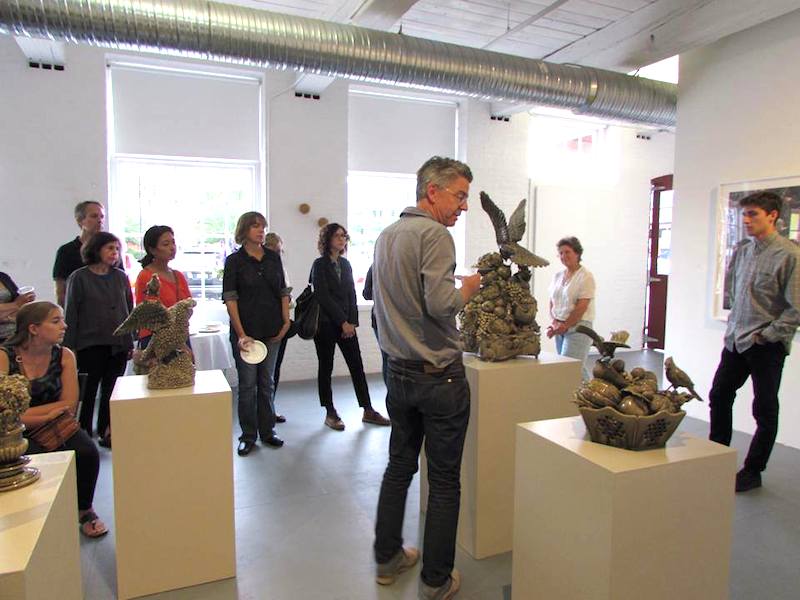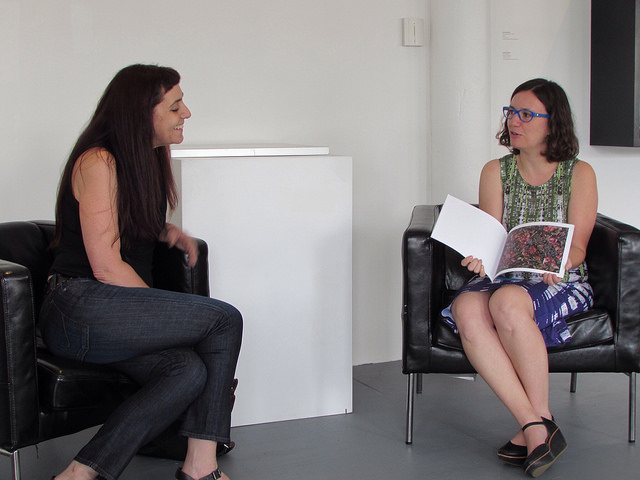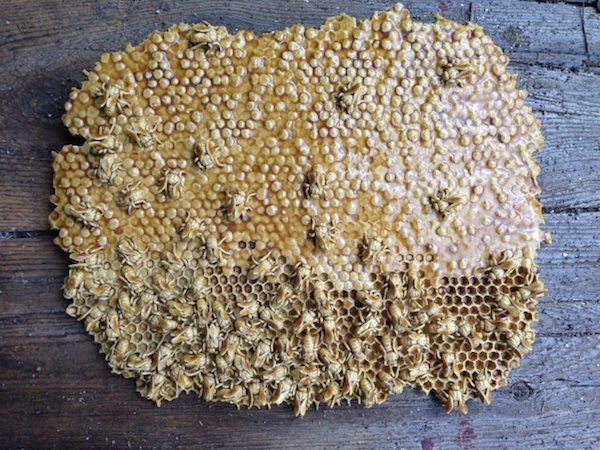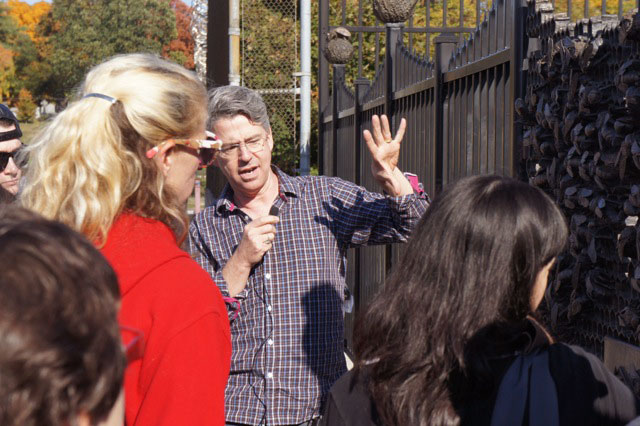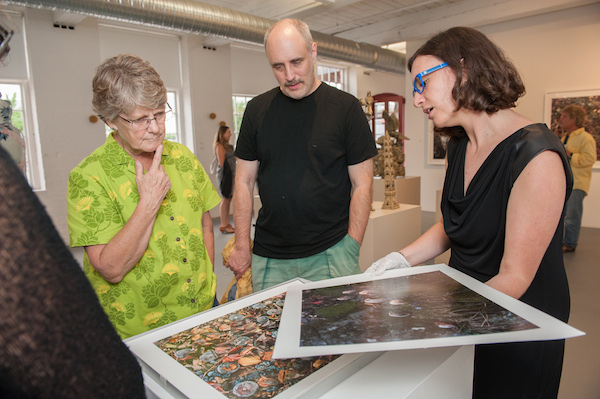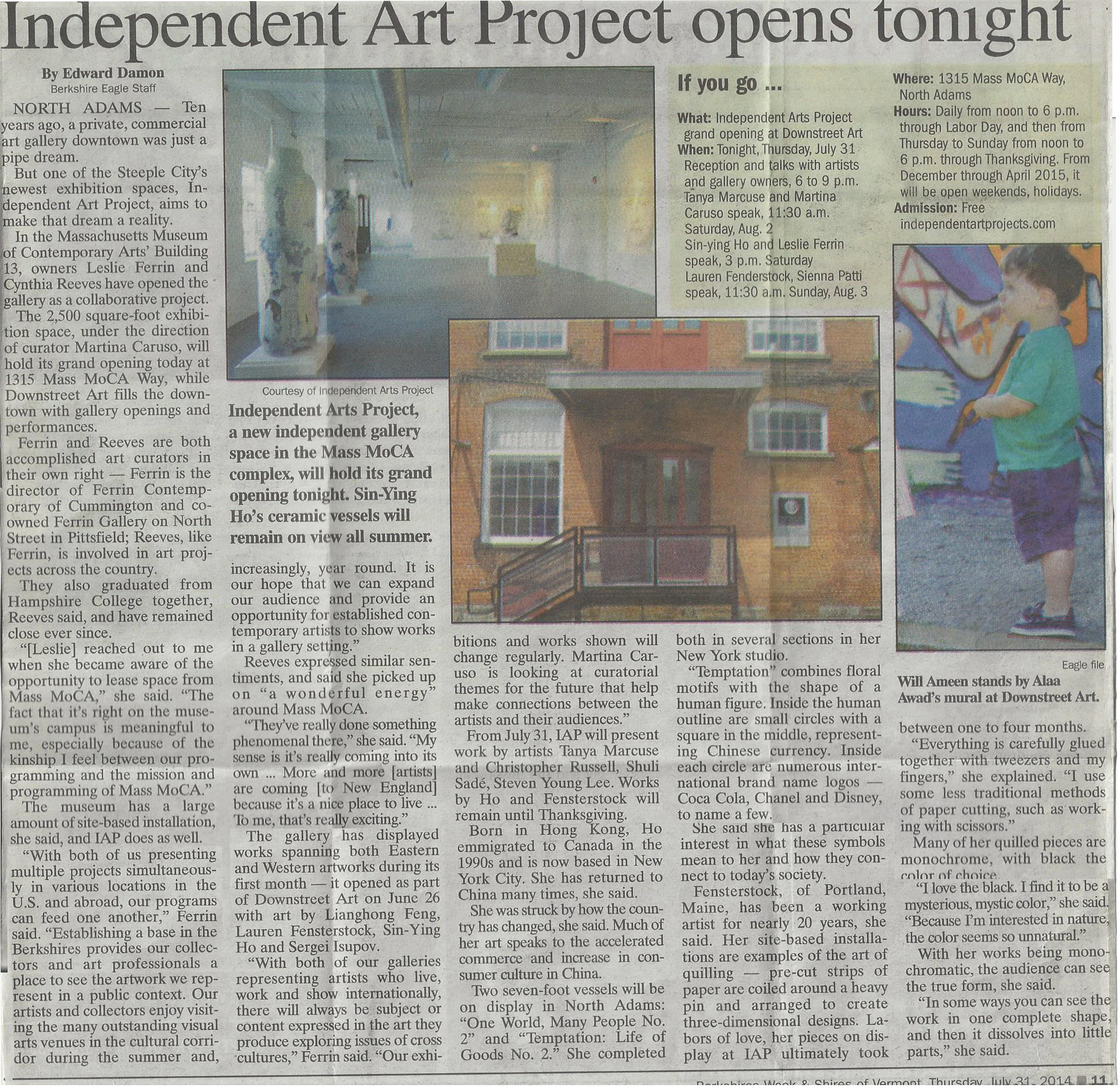Christopher Russell’s intricate terra-cotta sculptures explore themes of nature, craftsmanship, and museography. As part of his exhibition at Independent Art Projects, we invited Christopher to discuss his inspiration, process, and vision. This interview happened right after the artist gallery talk on Saturday, August 16. Russell’s works will be on view at IAP until Sunday, September 21, 2014.
Alexandra Jelleberg: Christopher, Thank you for taking the time to answer some more questions following your artist talk at Independent Art Projects. I remember the first time we met, when you delivered your pieces to the Mill in Cummington, Massachusetts, where Ferrin Contemporary is housed. This happened just after the whirlwind of activities that took place in the weeks before Independent Art Projects opened its doors. Leslie Ferrin and Martina Caruso (co-founder and director of IAP, respectively) had been in contact with Julie Saul (of Julie Saul Gallery, New York, the gallery which represents you) about showing some of her artists in our new space. Everyone agreed that you would be perfect for IAP’s summer exhibition. All seemed perfectly aligned until we realized Leslie would be in China and you would be gone for a residency in Scotland when it came time for your work to be delivered. The solution to this international conundrum lie in the upfront delivery of your work. I remember I was giving a tour of the Mill to fellow ceramic artist Sin-Ying Ho, while simultaneously looking out the window for you as you navigated your works to the site. Do you often have similar unique and interesting moments leading up to exhibitions?
Christopher Russell: The days leading up to a show, with all the logistics, are usually just really busy! Finishing everything, packing it up, delivering it to where ever it needs to go— it’s all a major military action. It is always very nice to deliver work outside New York City— after the whole ordeal of packing up the work, knowing that there will be parking at the other end seems so luxurious.
AJ: The works on view at Independent Art Projects were the first you hadn’t installed by yourself. While you must have been anxious about the loss of control over the details of the exhibition layout, you did get a chance to encounter your work with the element of surprise that your audience is normally privileged to. Were you able to have that magical moment of discovery when you saw your sculptures at IAP? Can you tell us a little bit more about this exhibition’s design process?
CR: It was exciting knowing that while I was away, in the Scottish Highlands, over in North Adams someone was taking the trouble to put my work up in the gallery; that people were coming to the opening and seeing the show, independent of me. And I am very pleased that it went so well. Even the piece that was most complicated to hang, the “Morning Glories”, seems to have gone up without problems. It has been a long term process for me, to figure out how to make my work independent of me; so that it can exist on its own, so I don’t have to be there like a stage mother, micromanaging. I have worked hard on designing my installation systems— so that they look good, but are also simple so others can most easily handle the pieces. It is a balancing act having the work exist in the space or on the wall the way I want it to while trying to be sure it’s simple enough to get it there, without the gallery installer getting to a point where they are cursing my name.
And it was exciting to come into the gallery and see how it was arranged—and again I was really pleased. I had never seen the “Morning Glories” properly installed before I saw the show, so it was nice to finally meet it.
Related to my efforts with my installation systems: These days I won’t be in a gallery for very long before I start inspecting how the artwork is installed, peering around the back of paintings to see what kind of system is used to get them to stay on the wall (I think it is an occupational hazard). Instead of looking at the artwork, I am studying how the frames are made. It’s like with any relationship— it is hard to keep the mystery alive!

Artist Sean Riley, installing Christoper Russell’s Morning Glory with Bees at IAP
AJ: It seems that the audience and the art world will forever be entranced by the artist process. You compared your role as an artist to that of a magician who is asked to tell his audience how his tricks work; can you tell us a little bit more about how have you been able to navigate simply having your audience encounter your work versus having to explain the meaning behind it?
CR: When I am making something, I want it to be expressive— not that I necessarily want it to get across a particular message; but I want it to radiate, to beckon. Part of what attracts a viewer is that sense of mystery, the promise of something to discover. I really do think that too much explanation on my part only serves to spoil that mystery. It’s best when the work does the talking.
AJ: “After the Golden Age” was first exhibited at the Julie Saul Gallery in 2012. Originally consisting of 45 ceramic objects on a wooden pedestal designed for the installation, the exhibition of the work at IAP features several pieces from that display. The crowded still life objects, each individual and handmade, were inspired by art history and the decorative arts, sometimes loosely and sometimes quite specifically. Do you feel the concepts of artificiality and material value you explore in these pieces are amplified by the medium of ceramics? If yes, how so?
CR: I like translating precious materials into ceramic. Clay is thought of as being a lowly, humble material; so making precious things out of it, things like jewels or precious metals, is fun because it plays up the question of what is important about the particular material an object is made from. I love silver work— so many amazing (even somewhat crazy) objects have been made with it over the centuries. It has a particular vocabulary of shapes and detailing. It’s interesting to me to make that kind of a form in clay— both because it is a beautiful vocabulary, but also because it interesting to see what that vocabulary says when translated into a non precious medium; when the preciousness is stripped away.

After The Golden Age installed at Julie Saul Gallery, 2012
AJ: While you were describing your work on view at IAP, I became fascinated by the comparison you made between yourself as a maker and the inherent identity of the worker bees in “Beework: Hive”. Was this the first time you found yourself mirroring your subject matter in the work that you make?
CR: That was a funny thing, that as I got into making many bees over a long time, I began to feel like one of the bees working away at my task. It was sort of like the cereal box thing, when the guy on the box is holding a box with him on the box. I have done some self-portraits over the years, and I always find that as I work on a self-portrait I end up feeling like I am increasingly stuck in a loop: looking in the mirror, looking at my drawing, looking in the mirror again. Add into that the increasing awareness that you can never really see your own face— it can actually get a little spooky.
Drawing from life is mentally exhausting for me — looking, understanding, and translating something onto a flat page is really hard intellectual work. It hurts my eyes! Working in 3D makes a certain aspect of that translation unnecessary—drawing realistically is always illusionistic, but sculpting in 3D isn’t illusionistic in that same way. So, for me, there is something less complicated about it. But it all demands that really hard part of looking and understanding your subject.
AJ: Watershed Center for the Ceramic Arts in North Edgecomb, Maine offers a variety of programs for artists from workshops and community firings to summer and fall residencies. We, like many ceramic artists, share the experience of having been resident artists there. When you mentioned how impactful Watershed Center for the Ceramic Arts was to you, I fondly remembered how amazing the space was for me as well. Would you describe your relationship with that particular residency?
CR: When I first went to Watershed, in 1990, I was still very much a painter and draughtsman. I was new to clay, and was a beginner both in my understanding of the material as a means of making art, and as a craftsman, as a technician. Three summers in a row I spent time at Watershed, and I learned so much, I really think of it as my graduate school experience. I was a lot younger then, and I worked like crazy, for hours and hours everyday. Being isolated there, with meals taken care of and no other obligations, I got really consumed by the project I did each summer. And I could ask the people around me about how to do things, and they would just tell me— I learned how to fire a kiln, how to make clay, how to make glazes… Along with that was the chance to be in that beautiful, rustic place. Bats flew around the studio! I was afraid of the dark when I got there. Learning to walk from the studio building back up to the sleeping hall, at 4 in the morning, in the dark with the stars out, I learned to love the dark, that feeling of being at peace in the night while knowing that all kinds of creatures were all around, doing their thing, just like you.
AJ: Your most recent residency was at ANTA in Fearn, Scotland. Could you tell us about this experience, and how residencies have shaped your work?
CR: The owners of ANTA, a wide ranging design firm based in the Scottish highlands, invited me to do a residency in their pottery workshop. I both did my own project and bounced around ideas about what they were doing. Again, it was an opportunity to get really focused. The ANTA workshops are in Fearn, a tiny village on a peninsula about 4 hours north of Edinburgh. It is extraordinarily beautiful there, a hybrid of farm land, seacoast and hills, with just amazing weather. From minute to minute the sky would change (I have never seen clouds like that) and when I arrived, being midsummer, it basically never got dark. Of course I had to do something that responded to such an environment, and I did so (perhaps perversely), by becoming pretty obsessed with the gazillions of snails that were around. They became my stand in for the whole environment. Now I am back in New York City, and I am still making snails. A residency is always a good way to reboot, let’s say; to go to a new place and just ask yourself, “Ok, what do I want to do?”
AJ: You spoke to the director of Independent Art Projects, Martina Caruso, about your recent public art work in at Sunset Park, Brooklyn, NY. Can you tell us a little bit more about how this project’s commission came to you, as well as how working in bronze compared to working in ceramics?
CR: The MTA (Metropolitan Transportation Authority) has a whole department which works to bring art into the New York transportation system: Arts for Transit and Urban Design. Through Percent for the Arts (the law that sets aside one percent of all public building budgets for artwork), they place site specific work in all the stations. My proposal was selected for the Sunset Park Station. It is a greatly enlarged version of my much closer-to-life-size ceramic bees. I liked the beehive theme in the context of the station, which seemed to me to be very much like a hive, with people rushing in and out, going about their business.
I had not worked in bronze before I started the project. I worked with a really good foundry, the Modern Art Foundry in Astoria, Queens. They made it possible for me to slip right in to the process. The big difference between my studio practice and working in the foundry is that foundry work is a group process, whereas my studio work is quite solitary. The whole scale of my studio work is largely determined by what I can do by myself.
At the foundry, there is a team of people at each step of the process, and it was often my job to tell people what I wanted instead of doing it myself. That is a very different skill. But in some way I came to understand that a whole foundry is in some way another tool: in the same way that a brush or a knife is a tool, it is a means by which to get an artwork to exist. Just as there are skills involved in making art with a brush, there are skills necessary to use a foundry to make art. It was interesting to learn about that similarity.

Bees for Sunset Park, north gate detail, 9th Avenue MTA subway station, Sunset Park, Brooklyn, NY.
——–
Christopher Russell studied at Wesleyan University and lives and works in New York. He has been a panelist for the Arts in Transit and Urban Design (New York, NY), a judge for the Scholastic Art and Writing Awards (New York, NY), and both resident artist as well as Advisory and Full Board Member at Watershed Center for the Ceramic Arts (North Edgecomb, ME). He recently completed a commission for the Metropolitan Transit Authority’s Arts for Transit who selected his design proposal for the 9th Avenue Brooklyn Station.
Alexandra Jelleberg is a Gallery Associate and Registrar for Ferrin Contemporary, and Artist Liaison for Independent Art Projects.
Contributions to this interview were made by Martina Caruso, Director of Independent Art Projects.

